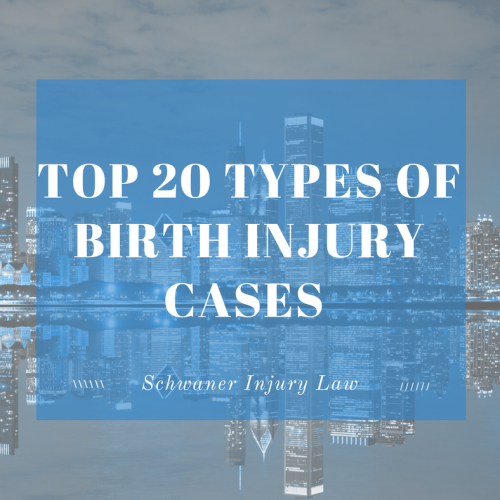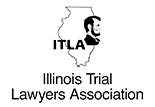
Top 20 Types of Birth Injury Cases in Chicago, Illinois
Although most babies in the United States are delivered without injuries, there is still a chance that the day of your baby’s birth won’t be without problems.
According to statistics, 29 out of every 1,000 babies in the U.S. suffer some kind of birth trauma, most often due to medical error. Five of those 29 injuries will be serious.
Some babies, however, are more at risk than others.
Birth trauma is more common in the following situations:
- Larger babies – more than 8 pounds, 13 ounces – may be too big to pass through the birth canal successfully, especially if the mother’s pelvis is narrow.
- Babies that are positioned abnormally at birth, such as in a breech, or buttocks first, position, are more at risk of injury.
- Babies who are premature are more prone to injury.
- Babies born after a prolonged labor may require the use of assisted birth instruments such as forceps or vacuum extraction, which can be used incorrectly.
- Babies whose deliveries are difficult, especially in cases of shoulder dystocia, may experience nerve damage that can be severe enough to cause paralysis.
WHAT BIRTH INJURIES ARE MOST COMMON IN ILLINOIS?
Table of Contents
Because most babies are delivered head first, a newborn’s head, neck and shoulders are most at risk of injury, although birth injuries are as diverse as the babies themselves.
According to experts, there are two main reasons by babies suffer birth injuries – either prenatal care was lacking (the mother took illicit or prescription drugs) or a doctor fails to properly assess risk factors or respond to emergency situations, causing problems due to medical negligence.
While cases are most often associated with a mother’s actions, prenatal care can also fall under medical negligence, especially if a doctor fails to diagnose pregnancy-related disorders. Some common problems associated with pregnancy include gestational diabetes and preeclampsia, a type of high blood pressure than can divert oxygen-rich blood from the baby, potentially causing brain damage if blood flow slows enough to kill off brain cells that need oxygen to survive. (Preeclampsia is one of the oldest of prenatal conditions, and was first mentioned by Hippocrates, considered the father of modern medicine, in the 5th century BC.)
ONE CHILD’S STORY
In 2016, a Cook County, Illinois, jury awarded $53 million to a family due to a debilitating birth injury, finding the University of Chicago Medical Center at fault for failing to prevent the injury.
The four-week trial came 12 years after Isaiah Ewing was born at the hospital, and was the highest compensation awarded in a birth injury case in the county.
The case was notable not only for the large award, but also because the case was won at trial, often considered a monumental task.
“It’s very tough to win a medical malpractice case at trial,” said John L. Kirkton, editor of the Jury Verdict Reporter. “More than seven out of 10 civil jury trials involving medical negligence go against the plaintiff.”
In Isaiah’s case, the lawsuit claimed that the boy’s brain injury could have been prevented if doctors had taken numerous preventative measures, including fetal monitoring that would have revealed an abnormal fetal heart rate, and performing a cesarean section in a more timely manner, at the first signs of distress.
“I laid there – no one came to check on me. No one,” said Isaiah’s mother, Lisa Ewing. “I thought I was getting the best care. I wasn’t.”
Because of the delay, Isaiah experienced hypoxia – the complete loss of oxygen for a period of time – and due to the brain damage caused by the death of brain cells, now suffers from cerebral palsy and developmental delays. He is unable to dress or bathe himself and requires his mother’s care for nearly every activity.
Attorneys for the hospital argued that the boy’s condition was more likely caused by an infection before his birth, and filed for a mistrial, although that request was denied.
“The University of Chicago has been, for the last 12 years, completely unapologetic, and even though the evidence was overwhelming that they caused Isaiah’s brain damage, they refused to accept responsibility,” said one of the family’s attorneys, Geoffrey Fieger, best known for representing assisted suicide advocate Dr. Jack Kevorkian, in court. They instead “mounted an obscene defense claiming that Isaiah’s brain injury was due to an unknown phantom infection.”
While Isaiah’s case is, fortunately, a rarity, the fact is, medical errors can happen, and they can mar one of the most joyful times in a family’s life.
When birth injuries happen in Illinois, it’s important that the legal rights of the children and parents suffering from such injuries are upheld.
SOME ILLINOIS BIRTH INJURY CASES SEEM AWFUL BUT ARE ULTIMATELY MINOR
While some birth complications are not related to medical negligence – maternal infections and birth defects can cause unavoidable problems – many are caused by a preventable birth injury.
And as a rule, most birth injuries are minor and will heal themselves over time.
Some common, minor Illinois birth injury types include:
- Bruising. Birth can be tough on a baby, no matter how large or how small he or she is. Sometimes, a baby will have bruising on his or her face or head, simply from the pressure of passing through the birth canal, which can involve coming into contact with the mother’s pelvic bones. Like the bruises we sustain when running into an object, they will fade with time.
- Forceps marks. In an adelivery deliver, a doctor may use forceps to help extract a child in distress, which can leave behind marks. While they may look terrible, like bruises, they, too, will fade.
- Caput Succedaneum. Despite the ominous name, this swelling of the baby’s scalp, usually the result of the use of a vacuum extractor, usually disappears within a few days.
- Minor fetal lacerations. Sometimes during a cesarean section, the baby will sustain minor cuts during the procedure. While some can be serious, causing lifelong scarring or disability, in most cases, such cuts are minor.
Some birth injuries are serious, however, and involve oxygen loss, nerve damage and other issues that can lead to devastating disabilities.
If your baby suffered a birth injury in Chicago or Illinois that caused permanent, debilitating problems, you’ll want an experienced medical malpractice attorney to be your advocate. The right lawyer will help secure the proper paperwork and records to help you win your case, ensuring compensation to help you cover the costs associated with long-term medical care.
Following is a closer look at the 20 most common birth injuries in Chicago.
***
1. Facial Paralysis Birth Injury – Did Your Newborn Baby Suffer Facial Paralysis After Birth?
 Some births are more difficult than others, and sometimes – usually due to a baby’s size or the improper use of forceps during assisted deliveries – that trauma can lead to facial paralysis (facial nerve palsy) that may or may not be permanent.
Some births are more difficult than others, and sometimes – usually due to a baby’s size or the improper use of forceps during assisted deliveries – that trauma can lead to facial paralysis (facial nerve palsy) that may or may not be permanent.
The paralysis, which most often reveals itself on the bottom part of the face, is the result of nerve damage. If the facial nerve – also called the seventh cranial nerve – is bruised, the paralysis is likely to resolve on its own within a few weeks. If the nerve damage is more severe, your baby may require surgery in order to repair the damaged facial nerves.
Causes of facial paralysis include:
- The use of forceps, which can put pressure on the nerves controlling facial muscles.
- A large baby. Infants that weight more than 8 pounds, 13 ounces, are more at risk of injury while passing through the birth canal.
- A long, difficult labor, which can mean an infant is in an injury-prone position for longer periods of time.
- The use of an epidural, which can cause contractions to slow so that a baby is in the birth canal for a longer period of time.
- Labor-inducing drugs, which can speed labor up too much, making injuries more likely during delivery.
Some of the symptoms associated with facial paralysis include:
- Muscle weakness around the lips.
- An eyelid that does not close.
- Facial features including the mouth may appear uneven when the baby is crying.
- Paralysis on one side of the face, which can extend from the forehead to the chin in the most severe instances.
While the condition is usually diagnosed shortly after birth, a nerve conduction test can determine the exact location of the injury, which may better determine the cause of the injury.
If the paralysis doesn’t resolve itself within a few months, surgery or physical therapy may be necessary in cases where the paralysis is not permanent.
If your baby suffered facial paralysis due to a difficult childbirth and you think medical malpractice may be to blame, it’s important to contact an experienced attorney who can help guide you through the process of filing a lawsuit and receiving the compensation you’ll need to cover the costs associated with your baby’s medical care.
2. Brachial Plexus Birth Injury – Brachial Plexus Injuries Impact One in 1,000 Newborns & Babies in Illinois
 The brachial plexus is a bundle of nerves that extends from the spinal cord around the shoulder, controlling the muscles of the arm, wrist, hand and fingers.
The brachial plexus is a bundle of nerves that extends from the spinal cord around the shoulder, controlling the muscles of the arm, wrist, hand and fingers.
Injuries to the brachial plexus occur when the nerves are damaged as the baby’s head passes through the birth canal but the shoulders don’t. This is known as shoulder dystocia, and it puts pressure on the neck and the brachial plexus nerves, stretching, rupturing or severing them.
When damaged, the nerve bundle can’t transmit signals from the brain to the arm muscles, causing varying degrees of disability. While some brachial plexus birth injuries heal after a few months – stretched muscles often respond well to therapy – ruptured or torn muscles will require surgery and usually result in limited range of motion or total paralysis.
Brachial plexus injuries most often impact the upper arm.
One of the causes associated with brachial plexus injuries is the misuse of an assisted birthing device such as a vacuum extractor or forceps, which can put pressure on an infant’s head or shoulders during delivery. A difficult natural delivery may also lead to brachial plexus injuries.
There are several factors that doctors should take into account when weighing the risks associated with a vaginal versus a cesarean birth, including:
- Abnormalities of the uterus that would narrow the birth canal.
- Maternal diabetes, which often suggests a large baby.
- Obesity, which narrows the birth canal.
- A multiple birth.
- A baby positioned in such a way that there will be shoulder pressure during the birthing process, including breech deliveries.
If your child suffered a brachial plexus injury at birth and you believe doctor error contributed to the injury, it’s important to contact an attorney with experience in birth injury medical malpractice lawsuits in order to get the compensation you need to cover the cost of your child’s care.
3. Erbs Palsy Birth Injury – Did Your Baby Suffer an Erb’s Palsy Injury at Birth?
 Erb’s palsy is a specific form of brachial plexus injury that occurs in one or two out of 1,000 births, when the baby’s head passes through the birth canal and the shoulders do not.
Erb’s palsy is a specific form of brachial plexus injury that occurs in one or two out of 1,000 births, when the baby’s head passes through the birth canal and the shoulders do not.
The brachial plexus nerves extend from the spinal cord around the shoulder, and are responsible for sending signals to the arm, wrist, hand and fingers.
Erb’s palsy most commonly occurs:
- When the infant’s head and neck are pulled to the side at the same time that the shoulders pass through the birth canal;
- When the shoulders are pulled during a head-first delivery; or
- When the baby’s arms are raised during a breech (buttocks or feet first) delivery, which puts pressure on the brachial plexus nerves.
In many cases the injury is a result of misjudgment on the part of the ob-gyn, who should, based on images and measurements, know how large a baby is before it is born, and make a determination regarding a cesarean section either before attempting a vaginal birth or if a vaginal birth becomes complicated.
The most common nerve injury associated with Erb’s palsy birth injury is neurapraxia, which occurs when the nerve along the neck is stretched but not torn. In most cases, any loss of movement or motor control heals within three months without intervention.
If the nerves stretch enough to cause scar tissue to develop or the nerves rupture or tear, the injuries are much more severe.
If, however, the injury does not heal, it is important to take action – either through physical therapy or surgery to repair tears or ruptures through nerve grafts or physical therapy – in order to take advantage of the small window of time, about three to six months, that offers the best chances for recovery.
If your baby developed Erb’s palsy as a result of a birth injury, it could have been caused by a medical error. It’s important to consult an experienced medical malpractice attorney, especially one who has handled birth injury cases, to get the compensation you’ll need to cover the costs associated with the injury.
4. Klumpke’s Palsy Birth Injury – Another Form of Brachial Plexus Injury
Another injury of the brachial plexus nerves is the rare but potentially debilitating Klumpke’s palsy, a birth injury that results from shoulder dystocia.
Klumpke’s palsy is almost always the result of a medical mistake and occurs when doctors either overlook risk factors, disregard ultrasounds showing that the baby is likely to be larger than normal or are too aggressive during the delivery process.
Some risk factors associated with Klumpke’s palsy include:
- A small pelvis, which makes delivery of larger babies more complicated.
- Gestational diabetes, which often is an indicator of a large baby.
- A baby that is past his or her due date.
- A baby that is larger than average, based on ultrasound readings and other measurements.
Klumpke’s Palsy impacts the muscles of the forearms and hands, and it reveals itself through symptoms ranging from weakened muscles in the impacted region to complete paralysis. Klumpke’s is also associated with Horner’s syndrome, which causes the eyelid on the side of the face opposite the brachial plexus injury to droop.
Because Klumpke’s palsy impacts only the lower nerves of the brachial plexus, it is often the result of neuropraxia, which is a stretching of only some of the nerves that make up the brachial plexus.
According to statistics from the National Institute of Neural Disorders and Stroke, in most cases, babies that experience neuropraxia-related Klumpke’s palsy as a result of a birth injury make a full recovery within three months of birth.
In more severe cases, however, nerve damage could be permanent, requiring physical and occupational therapy and surgery in order for some level of recovery to occur.
If your baby developed Klumpke’s palsy as a result of a birth injury, it’s important to seek the advice of an experienced attorney who has handled birth injury medical malpractice cases. The right attorney can help you receive the compensation you’ll need to cover the costs associated with your baby’s care.
5. Birth Injury Fracture – Fractured Bones of the Skull, Femur, and Humerus the Most Common Birth Injury Fractures in Illinois
Fractures are still the most common injury associated with childbirth, and in many cases, the fracture could have been prevented with proper care.
Some of the more typical birth injury fractures include:
CLAVICLE FRACTURES
Most often, the clavicle (collar bone) is broken during difficult or breech births, when pressure is put on the baby’s shoulder as he or she exits the birth canal.
Symptoms include a lack of movement of the baby’s arm, the baby holding its arm against the side of the body, or signs of pain when lifting the baby under the arms.
An X-ray can determine if a fracture has occurred, and although there is little treatment for a fractured clavicle (strapping the arm to the chest to keep it immobilized will help the fracture heal faster), broken collar bones heal quickly, and there are rarely complications associated with this injury.
SKULL FRACTURES
Skull fractures, on the other hand, can be much more serious.
They are often the result of pressure on the infant’s head as it passes through the birth canal, pressure on the baby’s skull caused by impact with the mother’s pelvic bone, or a difficult labor and delivery, which might require the use of forceps or a vacuum extractor.
There are several different types of skull, or cranial, fractures that can occur during delivery, including: linear skull fractures, which could impact the brain, spine and spinal cord; depressed skull fractures, which require surgical intervention to prevent brain damage; and occipital osteodiastasis, a rare type of skull fracture that can occur when a baby is born brow or face first, which is associated with a host of health problems including seizures and respiratory distress.
GROWTH PLATE FRACTURES
Growth plate fractures, birth injuries to the long bones of an arm or leg, usually don’t even show up in initial X-rays, although symptoms of the injury may be noticeable if swelling occurs. X-rays are more likely to reveal the injury during or after the healing process. With the protection of the fractured area, healing usually occurs within a few weeks.
FEMUR FRACTURES
Broken thigh bones are rare, but can occur if a baby’s leg is twisted awkwardly during birth. Signs of an injury will be evident when a child shows signs of pain when he or she is moved or during diaper changes. Treatment is a Pavlik harness, a soft device that stabilizes the bone, which is usually kept in place for about a month.
If your baby suffered a serious fracture during birth and you think it was the result of medical error, it’s important to contact an experienced attorney to determine if you have a case. If you do, your attorney can help you navigate the complex world of medical malpractice, taking care of the legal process so you can focus on your baby’s care.
6. Epidural Birth Injury – Epidurals Are Common But Can Cause Serious Complications
More than 50 percent of women who give birth in the United States choose to have an epidural to ease the pain associated with labor and delivery.
Usually a combination of local anesthetics and opioids or narcotics, epidurals are injected into the area surrounding the spinal cord to reduce pain during labor and delivery. There are a variety of different types of epidurals, including some that allow the mother to retain some sensation so she can stand or in some cases walk around to help alleviate discomfort and improve the birth experience.
While most epidurals don’t lead to complications, in some cases an epidural can result in birth injuries due to a wide range of unfavorable outcomes, including:
- Injuries from assisted delivery. Sometimes, an epidural prevents the release of hormones that speed the delivery process, slowing birth so much that vacuum extraction or forceps are required.
- The need for a cesarean section. Sometimes, the drug mixture causes the uterus to stop working entirely, forcing doctors to perform a C-section, which comes with its own set of potential complications.
- A difficult, slow delivery. Following an epidural, some infants may become too lethargic to get into the proper position for delivery, slowing the process and potentially leading to compression of the umbilical cord. This can result in a temporary loss of oxygen, which can potentially lead to cognitive disabilities or cerebral palsy, which can impact motor skills and cognition.
- Infant stroke or other brain injuries. Any loss of oxygen can trigger health problems.
- A lower fetal heart rate. The epidural drugs can travel from mother to baby, slowing bodily functions and putting the baby’s health at risk.
- Difficulty breastfeeding. Most commonly, the baby will have trouble latching on.
Poor muscle tone, coma, and wrongful death are other devastating potential birth injury cases in Illinois.
If you were given an epidural and your baby suffered a related birth injury as a result, you may be entitled to compensation. To find out, contact an attorney with experience in medical malpractice and birth injuries to find out your options.
7. Infant Spinal Cord Birth Injury – Did Your Baby Suffer a Spinal Cord Injury at Birth?
 Traumatic births can result in spinal cord damage, which is one the most devastating of birth injuries since it can potentially lead to paralysis.
Traumatic births can result in spinal cord damage, which is one the most devastating of birth injuries since it can potentially lead to paralysis.
Often caused by the use of too much force during the birthing process – a doctor may misjudge a baby’s size prior to a vaginal birth, requiring the use of assisted birthing devices such as forceps or vacuum extraction – injuries to the spine can cause serious physical or neurological injuries or death.
In addition to the misuse of assisted birthing devices, other risk factors for spinal cord injuries include:
- A fetus with a larger head than most babies.
- A baby with a larger birth weight than average.
- A baby with a lower birth weight than average.
- Prolonged labor, which can cause the baby to become constricted in the birth canal, putting him or her at risk of spinal cord injury.
- Rapid labor, which can cause injuries.
- Premature births, since the baby hasn’t reached full development.
- An abnormal birth position, such as breech birth.
According to experts, spinal cord and brain stem injuries often go undiagnosed after birth, and later reveal themselves through lasting neurological defects.
Some symptoms that will be more evident of a spinal cord injury in a baby include:
- Paralysis
- Spasms
- No sense of touch
- Abnormal breathing or reflexes
- Overall weakness
- Bladder or bowel control issues
Statistics show that between 10 to 33 percent of neonatal deaths are associated with spinal cord injuries.
Although it is a doctor’s medical and legal responsibility to manage your baby’s birth as safely as possible, mistakes can occur, especially if a doctor fails to take inventory of certain characteristics during ultrasounds and other diagnostic tests.
If your baby had obvious risk factors that your doctor overlooked, the standard of care wasn’t met, making it important to contact a medical malpractice attorney to help you recover the compensation you’ll need to cover the costs of your baby’s long-term care.
8. Cerebral Palsy Birth Injury – Another Common birth injury and is Very Complicated
Approximately two or three in 1,000 children have cerebral palsy, a disorder characterized by muscle spasms, weakened muscles and impaired motor skills. Occasionally, the disorder also includes cognitive disabilities.
While cases of cerebral palsy birth injury have diminished in recent years, the disorder is still a risk factor associated with traumatic birth.
To learn more about cerebral palsy birth injury click here.
Caused by brain damage, cerebral palsy can occur before, during and after birth, but is most often the result of damage that occurs while the baby is passing through the birth canal.
Some risk factors include cerebral palsy birth injuries include:
- The mothers birth canal is too narrow for the baby to comfortably pass.
- The fetus that is larger than normal.
- The mother has diabetes or has developed gestational diabetes.
- The fetus is positioned awkwardly prior to birth, which can cause pressure on the umbilical cord, cutting off oxygen.
Many cases of cerebral palsy are preventable with the proper precautions, meaning that some instances of cerebral palsy are the result of medical error. For example, a cesarean section should be scheduled if ultrasounds and other measurements determine that a fetus is dangerously large for a vaginal birth or other risk factors are determined.
Symptoms of the disorder include rigid limbs, exaggerated reflexes, problems with posture, involuntary movements or muscle spasms, posture problems and difficulty walking. Intellectual disabilities, vision and hearing loss and seizures are also potential problems associated with cerebral palsy.
Because not all cases of cerebral palsy are the result of medical error – gene mutations, maternal infections during pregnancy or a traumatic head injury shortly after birth – if your child was diagnosed with cerebral palsy, it’s important to seek out the opinion of an experienced medical malpractice attorney to help determine the cause of your child’s disability.
The right attorney can help secure the compensation you need to care for your child’s healthcare and rehabilitation, potentially for life.
9. Anoxia and Hypoxia Birth Injury – Oxygen Loss Can Cause Serious Injuries
As many as 20 percent of all babies experience a lack of oxygen at birth, according to the American Journal of Neuroradiology.
While many babies go on to make a full recovery, some suffer lifelong complications due to the brain damage associated with that lack of oxygen.
Oxygen is a vital nutrient, provided to infants through the umbilical cord.
There are two types of brain damage associated with oxygen loss. They include:
- Hypoxia is the deprivation of adequate amounts of oxygen, which can cause mild to moderate brain damage.
- Anoxia is the deprivation of all oxygen, which has the potential to cause severe brain damage or death, depending on the duration of time the brain goes without oxygen.
Both anoxia and hypoxia can lead to cerebral palsy along with a myriad of other health problems including cognitive disabilities that can last a lifetime.
While there are therapies in place to help babies that have suffered oxygen loss to make a full recovery – bringing down body temperature helps slow the body’s other functions allowing blood and oxygen to be sent to the brain, helping it heal – the risk of brain damage is still a factor.
Some reasons why babies lose oxygen and result in birth injuries include:
- Umbilical cord problems. Babies can be deprived of oxygen if the umbilical cord becomes twisted, knotted or prolapsed during birth, because the pressure from the baby passing through the birth canal can press the umbilical cord flat, cutting off or severely diminishing the flow of oxygen. Problems can also arise if a doctor cuts the umbilical cord too soon, before the baby is breathing fully on its own, or if the cord becomes wrapped around the baby’s neck during delivery, cutting off oxygen both from the cord and by preventing natural breathing after delivery.
- Blocked airways. A baby’s airways can become blocked with mucous, amniotic fluid and other substances during childbirth, preventing the child from taking in oxygen.
- Traumatic labor and deliveries. Some babies, often due to doctor error, are too large to pass through the birth canal and become lodged there, their shoulders unable to pass through. This particular problem can not only cause disabilities associated with nerve damage, it can also lead to brain damage if the placenta dislodges from the uterine wall due to the pressure. While assisted birthing devices such as forceps or vacuum extraction are an option, an emergency cesarean section offers the lowest risk of injury.
- Other factors. Infant jaundice, maternal infections and preeclampsia, which causes high blood pressure in the mother, potentially diverting oxygen-rich blood away from the baby – can also cause oxygen loss.
If your baby suffered a brain injury due to oxygen loss, it’s important to contact an experienced medical malpractice attorney to help you determine whether or not your case is one that should be pursued.
10. Forcep Birth Injury – The Use of Forceps Can Be Devastating
 Forceps are a method of assisted delivery that date back to the 1800s, and when used correctly, they are an important tool to help ensure a safe delivery for babies in distress.
Forceps are a method of assisted delivery that date back to the 1800s, and when used correctly, they are an important tool to help ensure a safe delivery for babies in distress.
They are most often used if the mother is unable to push the baby out of the birth canal, either due to exhaustion, a prolonged delivery, the loss of uterine function triggered by an epidural or illness. Forceps are also used when larger babies have difficulty passing through the birth canal.
Still, the tool presents a relatively high risk of birth injury, especially when used incorrectly.
Damage most often occurs when forceps are used improperly, which is a very real possibility during a rushed delivery with complications.
Some potential birth injury cases in Illinois associated with the use of forceps include:
- Bruising and lacerations. While most heal on their own, some lacerations can cause permanent disfigurement.
- Facial injuries including nerve damage. Facial paralysis is possible if nerve damage is significant.
- Fractures. Because a baby’s skull is so fragile, it can easily be broken is forceps are used incorrectly. Serious fractures can lead to neurological issues associated with brain damage. Incorrectly positioned forceps can also break the orbital bones that surround the eye, potentially causing damage to the eye.
- Intracranial hemorrhage. Such a hemorrhage is caused when blood vessels in the brain are torn, causing blood to fill the skull. The hemorrhage can cause strokes, seizures and developmental delays, and in the most severe cases, can lead to death.
- Brain damage. If the brain is bruised during the delivery process due to the use of forceps and swelling occurs, mild to severe brain damage is a possibility.
Most often, symptoms of a birth injury related to the use of forceps are clearly evident, and show themselves through bruising and lacerations on the face or skull. Babies with damage from forceps may also have a misshapen head, skull fractures or swelling.
Was your child injured by the use of forceps during delivery? If so, call an experienced Chicago-based attorney today to discuss your options.
11. Vacuum Extraction Birth Injury – These Types of Cases Can Cause Lasting Problems
Because of the risk factors associated with forceps, many doctors no longer use the device, and instead select vacuum extractors to assist during difficult or complicated deliveries.
During vacuum extraction, an obstetrician applies a vacuum with a soft plastic cup to the baby’s head and uses suction to help guide the baby out of the birth canal.
While safer than forceps, vacuum extraction ups the risks of birth injuries by 10 percent, according to statistics, and has earned warnings from the U.S. Food and Drug Administration, which in 1998 issued guidelines about the proper use of the device.
Some potential injuries associated with vacuum extraction found in Illinois cases include:
- Intracranial hemorrhage. The suction puts pressure on the brain and surrounding skull, causing bleeding that can lead to a variety of conditions including cerebral palsy, epilepsy and developmental delays.
- Superficial bruises or cuts.
- A cone-shaped swelling at the top of the head. Babies born via vacuum extraction are often born with a cone-shaped formation called a chignon, which usually resolves itself within days.
- Facial nerve damage. Damage can be significant, resulting in facial palsy.
- Eye injuries. Bleeding of the eye caused by pressure exerted by the vacuum.
- Jaundice. Vacuum extraction elevates the risk of jaundice in newborns, which can, if untreated, cause severe brain damage.
Vacuum extraction is also a risk for mothers, who have an elevated chance of sustaining vaginal or rectal tissue injuries, incontinence, pelvic organ prolapse and hemorrhaging that can lead to anemia.
If you or your baby were injured because your baby was not in the proper position for vacuum extraction, was too large to safely exit the birth canal or vacuum extraction was used before your cervix was fully dilated, it’s important to contact an experienced medical malpractice attorney who has handled birth injury cases to help you get the compensation you deserve to cover the costs of your injuries.
Because medical malpractice cases are complicated, it’s important to act quickly while witnesses, incident reports, and other information are more available.
12. C-Section Birth Injury – Cesarean Sections Can Be Life-Saving But Dangerous to a Newborn
Of births in the United States, more than 30 percent of deliveries are done via cesarean section.
The surgical procedure involves an incision into the mother’s abdomen and uterus from which the baby is extracted. It is routinely done if there are risk factors to childbirth, but there are also risks associated with the surgery.
If physicians are not careful during the procedure, a cesarean section can be fatal for both mother and child.
And if C-sections are performed incorrectly or at the wrong time, they can be cause for a medical malpractice case.
Some common C-section medical malpractice mistakes include:
- Not performing a C-section on time. If a baby is in distress, not acting fast to perform a cesarean can lead to devastating consequences including brain damage or death.
- Failure to monitor the vital signs of both mother and baby. If either the mother or her baby experience distress during delivery, a cesarean section is the best option. Missing signs of distress can result in serious birth injuries.
- Failure to call for a C-section when needed. If a baby is too large to be safely delivered vaginally, if the mother suffers from potentially life-threatening problems such as preeclampsia or placenta abruption, which cuts off the supply of nutrients to the baby, a C-section is the safest method of birth.
- Surgical mistakes during a C-section. While most cesarean sections go off without a hitch, leaving behind little more than a scar for Mom to remember the birth by, doctors are making incisions close to the baby, and can permanently injure a child, severing fingers or causing lifelong scarring if they cut too deep.
Mothers are also at risk during a cesarean, and can experience infections, anesthesia-related injuries, internal bleeding, hemorrhaging, blood clots and bladder or bowel injuries that may be difficult to repair because tissue is so fragile.
Did you or your baby suffered an injury during a C-section? If so, contact an experienced Chicago-based attorney now to help ensure that you’re compensated for medical bills, future health care and pain and suffering.
13. Jaundice Birth Injury – Newborn Jaundice Can Cause Serious Injuries
Jaundice is common in infants. About 60 percent of all babies are born with the condition, caused by high levels of bilirubin, a substance that results from the breakdown of red blood cells.
It is usually nothing to worry about. But sometimes jaundice, more common in babies that are premature or born with dehydration or infection, can be deadly.
While bilirubin breaks down naturally and is removed from the body by the liver, newborns with jaundice have produced too much bilirubin for the liver to process and expel, resulting in a yellowing of the skin and the whites of the eyes.
While jaundice usually clears up on its own as the liver catches up and removes excess bilirubin, the substance can reach toxic levels in the infant’s blood, and if left untreated, can travel to brain tissue, resulting in a specific form of brain damage called kernicterus.
Kernicterus can cause myriad neurological disorders, including:
- Intellectual disabilities.
- Motor function disorders.
- Seizures.
- Hearing or visual impairments.
- Cerebral palsy.
- Digestive function impairments.
The American Academy of Pediatrics recommends measuring bilirubin levels within 24 hours of the first signs of jaundice. If levels are dangerously high, a blood test can diagnose kernicterus, allowing doctors to immediately begin treatment to prevent potentially devastating complications.
Treatments include light therapy, the administering of fluids or blood transfusions.
While jaundice can be caused by a variety of factors including differing blood types between mom and baby, maternal infections, and blood diseases, parents should be warned of symptoms – aside from the yellowing of skin, infants with jaundice can be lethargic and may refuse bottles or breast milk – before they leave the hospital, so that the condition can be treated before it becomes dangerous.
If your child had newborn jaundice and developed complications associated with kernicterus, you may want to contact a Chicago medical malpractice attorney to discuss taking legal action, not only to secure compensation for your child’s health care, but also to prevent similar situations from happening to other new parents and their children.
14. Placental Abruption Birth Injury – Extremely Rare, But Dangerous to Newborns
 While fewer than 1 percent of pregnant women experience placental abruption – a condition caused when the placenta separates from the wall of the uterus, depriving infants of nutrients and oxygen – it can be life-threatening for both mother and child.
While fewer than 1 percent of pregnant women experience placental abruption – a condition caused when the placenta separates from the wall of the uterus, depriving infants of nutrients and oxygen – it can be life-threatening for both mother and child.
Placental abruption can occur without warning during pregnancy or it can occur during a traumatic birth. Because the condition immediately cuts off nutrients and oxygen to the baby, there is very little time to take action.
If doctors fail to move quickly or fail to properly diagnose placental abruption, potential problems include preterm birth, stillborn birth, growth issues and brain damage that could result in cerebral palsy if the infant goes without oxygen for a long period of time.
The mother may also sustain a dangerous loss of blood.
The most common response is a cesarean section, although if the placental abruption occurs during labor, a vaginal delivery may still be possible.
Doctor error could play a role in placental abruption, especially if a medical team fails to properly monitor when certain risk factors are present, including:
- Abdominal trauma.
- Advanced maternal age.
- Drug use.
- Diabetes.
- Multiple birth.
- Membrane ruptures.
- High blood pressure.
Symptoms of placental abruption include severe abdominal and back pain, bleeding, uterine pain and contractions and an abnormal fetal heart rate.
The condition can be diagnosed with an ultrasound or blood tests.
If your baby was injured as a result of placental abruption either before or during childbirth and your doctor failed to diagnose the condition or take action quickly, you may have grounds for a medical malpractice lawsuit.
Contact an experienced Chicago-based attorney or check out our chicago birth injury attorney guide to determine if you have a case.
15. Uterine Rupture Birth Injury – Another Dangerous Type of Injury for Mother and Baby
The uterus is the only barrier of protection for a fetus during pregnancy, and uterine rupture – the tearing of all layers of the uterus – can expose the baby to a wide range of toxins if the child tumbles out of the torn uterus into the abdominal cavity.
There is also the risk of oxygen loss if the rupture occurs near the placenta, which could cause the placental abruption.
The two conditions are closely associated. Placental abruption is a major risk factor for uterine rupture because the area where the placenta separates from the uterine wall is weakened, and it is responsible for almost one-fifth of all cases of the potentially catastrophic condition.
Risk factors of uterine rupture include:
- Medical misuse of oxytocin (brand name Pitocin), a drug used to help induce labor. Oxytocin can cause strong, frequent contractions that put too much strain on the uterus.
- A mother’s pelvis is too small for the baby to pass through the birth canal without potential problems.
- The mother has given birth five or more times, which weakens the uterus.
- The baby is positioned in such a way that extra pressure is put on the uterus during vaginal deliveries.
- Placental abruption. When the placenta separates from the uterine wall, it can weaken the area, causing ruptures. According to statistics, almost one-fifth of all uterine ruptures are associated with placental abruptions.
- The misuse of assisted birthing devices such as forceps and vacuum extraction devices. Internal version, which is when the physician inserts a hand into the uterus to turn the baby, can also cause uterine rupture.
- Previous cesarean sections, which can cause weakened areas of the uterus, especially if the scar did not heal properly.
Because uterine ruptures put both mother and baby in immediate distress, the outcome can be catastrophic.
If an infant is deprived of vital oxygen during birth, the results can be permanent brain damage, cerebral palsy or death. Ruptures can also cause potentially fatal bleeding for the mother if not treated in a timely manner.
If you or your baby were injured due to a uterine rupture that was the result of medical error, contact a Chicago-based attorney as soon as possible to discuss your case.
16. Brain Hemorrhage Birth Injury – Did Your Baby Suffer a Brain Hemorrhage During Birth?
A brain hemorrhage is a type of stroke caused when an artery in the brain bursts, causing the tissue surrounding the artery to bleed, killing brain cells.
Brain hemorrhage, or intracranial bleeding, can be caused by birth injuries including the baby being dropped after delivery, blunt force trauma to the newborn’s head, the improper use of tools for assisted births or high blood pressure passed from mother to baby. All of these are preventable with proper medical care.
The symptoms commonly found in brain hemorrhage birth injury cases in Illinois include:
- Difficulty swallowing
- Lethargy
- Loss of consciousness
- Weakness in an arm or leg
- Seizures
- Nausea or vomiting
Brain hemorrhages can be diagnosed with a head CT scan and an MRI, which can provide imaging of the brain that will pinpoint exactly where the blood vessel has burst, making a dangerous surgery less of a risk. It is vital, however, that brain hemorrhages are treated quickly in order to prevent the death of more brain cells, resulting in more severe brain damage.
In addition to brain bleeds, infant brain birth injuries can cause bleeding in several other areas of the skull. These include:
- Subarachnoid hemorrhages. The most common form of intracranial hemorrhage, subarachnoid hemorrhages occur beneath the two membranes closest to the brain, and can trigger seizures.
- Subdural hemorrhages. This bleeding occurs between the inner and outer membranes covering the brain, and can cause seizures as well as high levels of bilirubin in the blood, which can cause jaundice, which left unchecked can lead to debilitating brain damage.
- Cephalohematoma. While most cases of cephalohematoma, which is bleeding between the skull and the periosteum (the membrane covering bones including the skull), are the result of birth trauma, they most often resolve themselves as the blood is reabsorbed. Jaundice is a potential problem, however.
If your child suffered brain damage at birth as a result of brain hemorrhage and you believe it was the result of negligence by medical professionals, it’s important to contact an attorney who specializes in infant brain damage medical malpractice cases to help guide you through the painful process. Attorneys familiar with the complexities of medical malpractice will be better able to secure the necessary compensation you will need, especially if faced with caring for your child for a lifetime.
17. Umbilical Cord Birth Injury – Was Your Baby Injured Due to Umbilical Cord Issues at Birth?
 The umbilical cord is your baby’s lifeline, as it links your child to the placenta, which provides both oxygen and nutrients throughout the pregnancy and delivery.
The umbilical cord is your baby’s lifeline, as it links your child to the placenta, which provides both oxygen and nutrients throughout the pregnancy and delivery.
Umbilical cord problems can cause significant injuries during childbirth, in some cases leading to debilitating lifelong problems.
Some common umbilical cord problems commonly found in birth injury medical malpractice cases include:
- Umbilical cord prolapse. When the umbilical cord drops through the cervix during labor, the baby compresses it as he or she exits, either cutting off oxygen or getting tangled in the cord. According to statistics, 1 in every 300 births result in umbilical cord prolapse. Most common during breech or premature deliveries or when the umbilical cord is long or there are excessive amounts of amniotic fluid, umbilical cord prolapse can be potentially deadly as it can cut off oxygen entirely, causing cerebral palsy, cognitive disabilities or death.
- Nuchal cord. A nuchal umbilical cord is one that is coiled around the baby’s neck. It occurs in 10 to 30 percent of all births, and can also lead to a loss or diminished flow of oxygen. More common for male infants, nuchal cord is a risk factor when the mother is carrying twins, the baby is breech or shoulder first or the baby is excessively large. Restricted blood and oxygen can lead to limited fetal development.
- Umbilical cord knots. If an infant moves around extensively, he or she can move through the umbilical cord, creating a knot. During delivery, the knot can tighten, cutting off oxygen and potentially causing brain injuries or death.
- Umbilical cord stricture. The National Institutes of Health reports that umbilical cord stricture is a common cause of fetal death. Umbilical Cord Cysts
While most umbilical cord problems are not considered birth injuries, if a physician fails to detect a problem or fails to monitor fetal vital signs during labor and delivery, they could fall under the category of medical negligence, allowing for a medical malpractice lawsuit.
Because the issue can be complicated, it’s important to talk to an experienced medical malpractice attorney if you believe that your child’s umbilical cord injury was the result of medical negligence.
18. Preeclampsia Birth Injury – If Preeclampsia is Mismanaged, It Could Be the Result of Negligence
Preeclampsia occurs when a mother whose blood pressure was previously normal develops high blood pressure during pregnancy, along with excess protein in the urine.
Because high blood pressure can divert blood from the developing fetus, restricting access to oxygen and other vital nutrients, it is a condition that requires close monitoring in order to ensure that both mother and baby are safe.
While there is no standard treatment for preeclampsia, cesarean sections are recommended to decrease the health risks associated with the condition.
Preeclampsia is risky for both mothers and their babies, and in about a quarter of all cases, it can result in severe complications, and progress into the more serious eclampsia.
Mothers are at risk of seizures, organ failure, blood clots and central nervous system concerns.
For the developing fetus, the condition can be even more serious, and can result in placental abruption, low blood flow and premature birth.
Possible complications of preeclampsia birth injury include:
- Hypoxic ischemic encephalopathy. When the brain and spinal cord are deprived of oxygen, potential problems can include intellectual and developmental delays or death.
- Cerebral palsy. The condition impacts motor function and potentially cognitive abilities as well
- Seizures.
- Problems associated with intrauterine growth restriction. Because preeclampsia can slow nutrients, fetuses can experience slower growth, which presents risk factors for injury if a pregnancy goes beyond the predicted due date or labor and delivery are prolonged.
Because preeclampsia is associated with so many potential dangers, it is important that doctors diagnose the condition early and monitor the condition regularly. Failure to do so could be considered negligence.
If you or your baby suffered complications from undiagnosed or unattended preeclampsia, you may have grounds for a medical malpractice lawsuit. In order to recover the compensation you’ll need to cover health care costs, it’s important to contact an experienced medical malpractice attorney who has handled birth injury cases to discuss your case.
19. Medication Birth Injury – Did Drugs to Induce Labor Cause Birth Injuries?
CYTOTEC
While Pitocin is the only drug approved by the Food and Drug Administration to help induce labor, the stomach ulcer drug Cytotec (misoprostol) is sometimes used instead.
Cytotec is used to help dilate the cervix, but because it absorbed vaginally, its use cannot be discontinued if there are complications, and predicting how a mother will react to the drug is impossible.
The risk of birth injuries is severe, because it can cause hyperstimulation, which causes uterine contractions that are too strong and too close together, resulting in a fast, dangerous delivery, bleeding, uterine rupture and the need for an emergency cesarean section.
Potential drug complications that result in birth injury cases in Illinois can include:
- Hypoxic ischemic encephalopathy from oxygen deprivation if uterine rupture occurs.
- Dangerous changes in fetal heart rate caused by hyperstimulation.
- Umbilical cord compression, also a risk factor associated with hyperstimulation, which can cause permanent brain damage from a lack of oxygen.
- Cerebral palsy, which impacts motor function and can potentially lead to cognitive problems as well.
- Intellectual and developmental disabilities.
Because Cytotec has been linked to uterine rupture, the American College of Obstetricians and Gynecologists in 1999 advised that the drug not be used to induce labor in women who have had a cesarean section.
PITOCIN
Pitocin is a synthetic form of oxytocin, the hormone produced by the body during labor to induce uterine contractions.
If labor is slowed for any reason – sometimes because of the administering of an epidural for pain – Pitocin is often used to speed up labor.
If the drug is misused, however, there are potential risks, including brain damage caused by oxygen deprivation, which can happen when the placenta doesn’t have time between faster contractions to replenish the supply of oxygen it is providing to the baby.
If you or your baby suffered injuries due to the misuse of drugs used to induce labor, contact a Chicago-based medical malpractice lawyer to determine your legal rights.
20. Meconium Aspiration Birth Injury – One Baby’s First Breath of Amniotic and Meconium (Stool) Can Cause Serious Injury
While every first that your baby experiences is big news, there is one that can cause serious injury if not treated properly.
During traumatic births, infants are at risk of developing meconium aspiration syndrome, a potentially life-threatening condition that happens when a baby breathes in a mix of amniotic and meconium, another name for a baby’s first stool.
In normal birth situations, meconium remains in the intestines until after delivery. A baby in distress, however, can release the stool into the amniotic fluid, where it can be breathed into the lungs.
While it is rarely talked about, meconium aspiration syndrome is a common birth injury, and it is considered a medical emergency.
Potential problems for newborn babies who inhale Amniotic and Meconium (Stool) include:
- Blocked airways.
- Decreased oxygen supply.
- Pneumonia.
Because the baby’s airways are blocked, cutting off essential oxygen, it’s important that doctors work fast to extract the baby and reopen blocked airways to prevent potentially lifelong complications.
If a baby doesn’t receive medical treatment immediately, they are at an even higher risk.
Common symptoms of meconium aspiration syndrome include:
- The baby is a bluish color immediately after birth, suggesting low levels of oxygen.
- The baby has difficulty breathing, and either isn’t breathing or is breathing more rapidly than normal.
- The baby has low blood pressure.
- The baby is limp and unresponsive.
- The baby has a low Apgar score. Apgar testing was developing in the 1950s to evaluate the overall health of a newborn.
- Meconium in the amniotic fluid.
Because oxygen loss can quickly result in brain damage, it is imperative that a medical team act quickly to prevent problems associated with MAC.
If your child suffered brain damage due to meconium aspiration syndrome, it’s important to contact an experienced Chicago-based medical malpractice attorney to evaluate your case. If a medical error caused the problem, you are likely entitled to compensation to cover the costs of caring for your child.
 At the age of 31, David J. Schwaner became one of the youngest attorney’s in the history of Illinois to win a gross jury verdict of over 1 million dollars. Now, after working to recover millions of dollars on behalf of clients, David is a renowned personal injury attorney on a mission to fight back against the insurance companies and get you the financial compensation you deserve. Call 312-635-4000 to speak to David today.
At the age of 31, David J. Schwaner became one of the youngest attorney’s in the history of Illinois to win a gross jury verdict of over 1 million dollars. Now, after working to recover millions of dollars on behalf of clients, David is a renowned personal injury attorney on a mission to fight back against the insurance companies and get you the financial compensation you deserve. Call 312-635-4000 to speak to David today.












